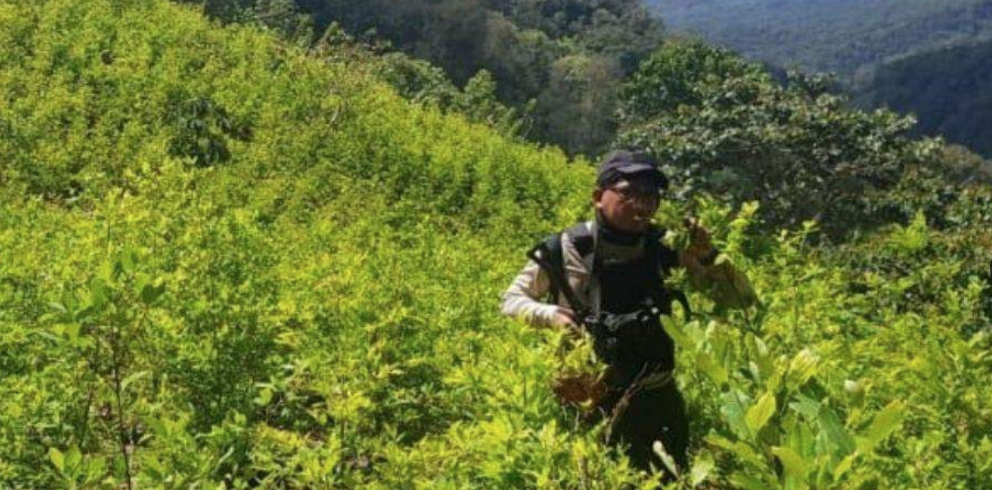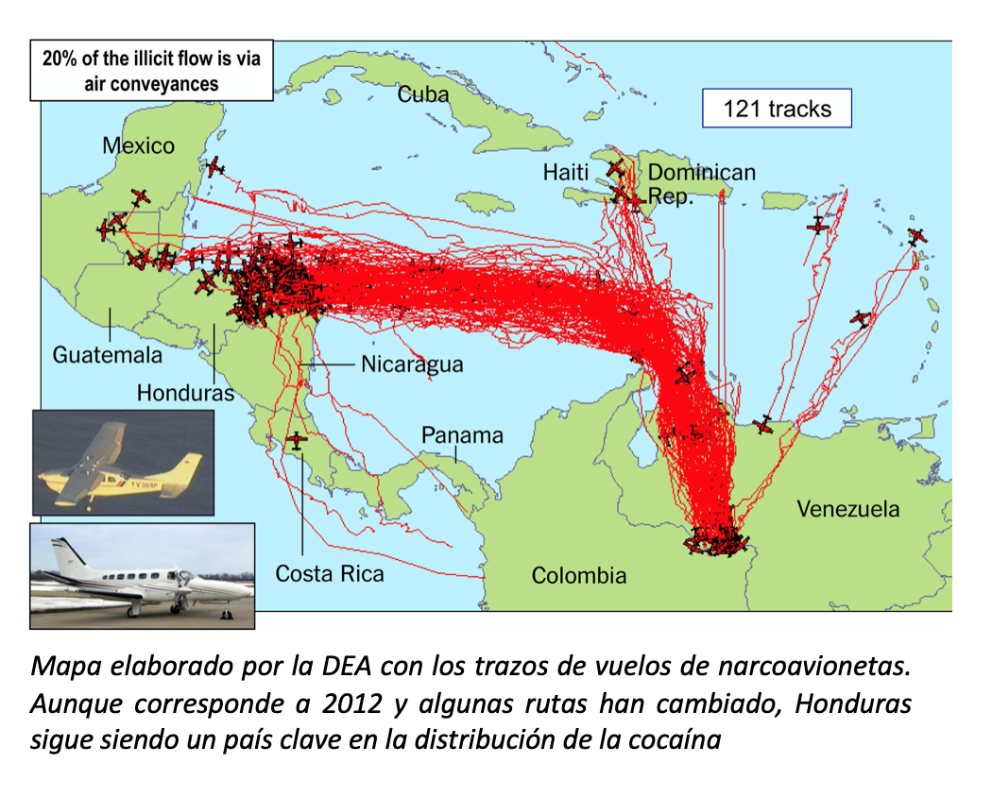Both are consolidating their start as producing countries, which represents an important qualitative leap despite the fact that production is still very limited.
° The first plantations were discovered in 2017 in Honduras and in 2018 in Guatemala; since then, more than 100 hectares of coca bush have been located.
° During 2020, Honduras eradicated 40 hectares of coca cultivation and Guatemala 19 hectares; in addition, almost twenty cocaine processing laboratories were destroyed.
° The extension of coca production into Central America is the work of Mexican cartels, which employ Colombian experts in locating the best areas for cultivation.

► Honduran anti-narcotics action in a coca plantation in October 2020 [Gov. of Honduras].
report SRA 2021 / Eduardo Villa Corta [ PDF version].
MAY 2021-Cocaine production has begun to spread to countries in Central America, which until recently were only transit points for cocaine coming mainly from Colombia, which is the world's largest producer, along with Peru and Bolivia.
The finding of laboratories for processing the drug in Honduras in 2009 already suggested the beginning of a change, confirmed by the location of coca bush crops themselves in 2017 in the same country and in 2018 in Guatemala. Since then, more than a hundred hectares have been located in both countries: those first two years some 50 hectares were counted together, a figure that was doubled in 2020 in what appears to be an acceleration of the process.
In any case, these are very small extensions, compared to those estimated by the United Nations Office on Drugs and Crime in its 2020 report for Colombia (around 180,000 hectares), Peru (almost 50,000) and Bolivia (around 25,000). In addition, the United States claims to have no record of cocaine generated in the Central American Northern Triangle entrance its territory.
Everything indicates that for now we are in a stage of experimentation or essay by Mexican cartels, which would be testing the aptitude of the terrain and climate of different areas and the quality of the product, with the financial aid of Colombian experts. Changes in the drug trafficking chain since most of the FARC left the illicit business in Colombia and the desire to reduce the complex logistics of transporting drugs to the United States explain these attempts in the Northern Triangle.
Honduras 
In Honduras, the location of crops has increased in the last two years. The latest International Narcotics Control Strategyreport (INCSR), dated March 2021, prepared by the US State department , includes official Honduran information accounting for the eradication in the first ten months of 2020 of 40 hectares of coca bushes. This represents an increase in the accounting of cultivation areas compared to previous years, which estimated the accumulation of 50 hectares throughout 2017 and 2018 in Honduras and Guatemala together.
The first evidence in Honduras that drug traffickers were not only using its territory as a transit point was the finding in 2009 in the province of Cortes of a laboratory for the transformation of coca leaves into cocaine hydrochloride. In ten years, twelve laboratories were discovered, and in 2020 alone the authorities proceeded to destroy at least eleven others, according to the INCSR. Although some had the capacity to produce up to 3.6 tons of cocaine per year, their facilities were rather "rudimentary," according to Honduran law enforcement agencies.
The existence of these laboratories led to the conclusion that at least since 2012 some amount of coca leaf could be growing in the country, but it was not until 2017 that a cultivated area was found, in the province of Orlando, with some 10,000 plants. In 2018, three other farms were located, one of which was 20 hectares. Cultivation and laboratory activity is not concentrated in a specific area, although half of the findings have been made in the aforementioned provinces of Orlando and Colon.
The last location reported, in a process of locating increasingly visible crops, was the one carried out by the National Anti-Drug Trafficking Directorate (DLCN) in March 2020, which corresponded to a field of about 4.2 hectares of cultivation and laboratory in the community of Nueva Santa Bárbara. In 2020, at least 15 coca fields were seized, with a total of 346,500 plants.
The DLCN estimates that Mexican cartels, such as those of Sinaloa and Jalisco, are behind this penetration, although they do not operate directly, with a deployment of armed individuals, but on several occasions through growers of Colombian origin, who know how to take care of the coca plant.
Recent convictions in the United States, such as that of the brother of Honduran President Juan Orlando Hernandez, have provided details of the drug trafficking corridor that is Honduras, but also the incipient homegrown production. As his trial exposed, Tony Hernandez, sentenced to life in prison in March 2021, had a direct relationship with a local cocaine laboratory .
Guatemala
In the case of Guatemala, the first finding of coca leaf cultivation took place in 2018. Although it was only one hectare in size, with 75,000 plants, it also meant the leap to incipient producer country. In addition to having been, like Honduras, a passageway for cocaine coming from Colombia, Guatemala had already distinguished itself for a moderate production of marijuana and for having begun to grow poppy, by extension of the activity of Mexican cartels involved in the heroin market, of which Mexico is the leading producer in the Americas. Now Guatemala, where narco-laboratories have also appeared, included coca among its illicit narcotics crops.
In 2019, Guatemalan authorities made an effort to combat this activity. On September 4 of that year, they declared a 30-day state of siege in 22 municipalities in the north of the country. Police operations involved several seizures, especially in the Departments of Izabal, Alta Verapaz, Petén and Zacapa. Some 23 cultivation areas were located, eight of them in Izabal.
As a result of these findings, Interior Minister Enrique Degenhart admitted that Guatemala had become a cocaine-producing nation.
In the first ten months of 2020, 19 hectares of coca cultivation were eradicated and seven laboratories were destroyed, as indicated by the latest INCSR, specifying, in any case, that coca production in Guatemala has a "limited scale" (as in Honduras, but even below the neighboring country), at a distance from that recorded by the largest South American producers.
Increased role for gangs
Authorities in Honduras and Guatemala fear, due to increased drug production activity, that some areas of their countries will become the new "Medellin of Pablo Escobar". The existence of areas that are difficult to access and the lack of means to supervise and combat organized crime complicate counter-narcotics activities.
There is also a risk that the gangs or maras will gain even more power, entrenching or even aggravating the problem they pose. Because of their dominance of space, they have so far taken tolls for the passage of drugs throughout the territory, but with production in the Northern Triangle itself, they could also come to control the very origin of the drug, giving them the prerogatives of the cartels.
At the same time, international coordination against drug trafficking is complicated by the fact that it is more difficult to locate production centers and identify the actors involved in this activity.